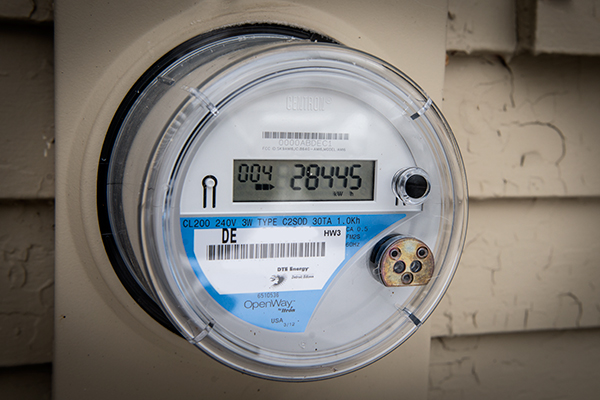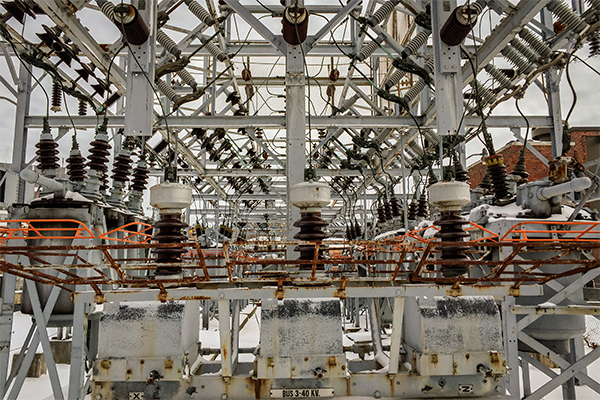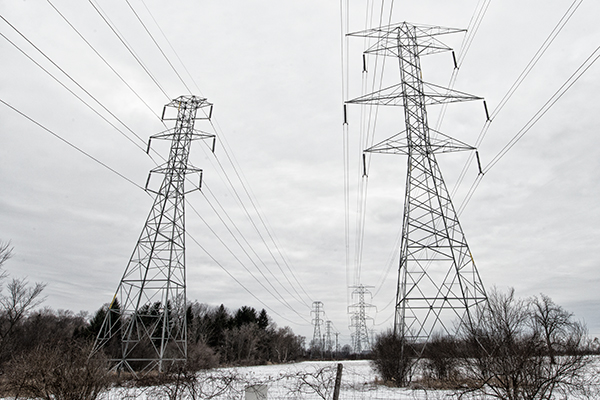How 'smart' is Michigan's electrical grid?
Nina Ignaczak |
Thursday, January 22, 2015
It's a blistering summer heat wave. People are running for the comfort of their air conditioners. And it's starting to put a strain on the electrical grid.
But you're smart. You've pre-arranged for your utility to cycle your air conditioner on and off during periods of high electricity demand. You save a little money on your electricity bill, and the utility reduces demand on the grid, avoiding rolling blackouts in your neighborhood.
The best part: You don't really notice, because the fan stays on while the condenser is off, so the house stays cool.
Sounds like a scenario from the future, right?
Actually, such a program has been available since the 1970s, according to Derek Kirchner, who supervises DTE Energy's demand response program.
"We were one of the first utilities in the country to do this," says Kirchner. "The program has been around since 1978, so it's as old as I am. You could call up today and say, 'Hey, I want to go on the interruptible air-conditioning program.'"
DTE's interruptible air conditioner program is an early example of a "smart grid" innovation that balances demand and response to improve the overall reliability and performance of the electrical grid. The program requires a second meter, so the upfront cost deters many customers from participating. But as the electricity sector modernizes and leverages internet technology, such programs will become cheaper and more ubiquitous.
So what's a "smart" grid?
The United States Department of Energy defines "smart grid" as "the electricity delivery system (from point of generation to point of consumption) integrated with communications and information technology for enhanced grid operations, customer services and environmental benefits."
You might already have a digital "smart meter" (advanced metering infrastructure, or AMI), which reports your usage regularly to your utility. AMI allows consumers to access their daily power reports on the internet, facilitates more accurate billing, and negates the need for a meter reader to enter the property.
 "We’re reducing our carbon footprint by avoiding sending out the trucks for monthly meter reads," says Bob Sitkauskas, DTE's manager of advanced meter infrastructure. "We can now ping the meters and see if it has returned to service during an outage. That's a big advantages for us when we’re doing customer service."
In addition to demand response programs like interruptible air conditioning, smart grid technology can proactively identify energy efficiency opportunities, improve reliability by more quickly and accurately pinpointing the cause of outages, facilitate two-way power flows for distributed generation (like rooftop solar panels that sell power to the grid), better accommodate the fluctuations of intermittent energy sources (like wind energy), and better allocate peak energy costs so that those who use power during high-demand periods are the ones who pay for it.
How "smart" is Michigan's grid?
Between 2007 and 2012, the Michigan Public Service Commission initiated the "Smart Grid Collaborative," a group of experts from the
"We’re reducing our carbon footprint by avoiding sending out the trucks for monthly meter reads," says Bob Sitkauskas, DTE's manager of advanced meter infrastructure. "We can now ping the meters and see if it has returned to service during an outage. That's a big advantages for us when we’re doing customer service."
In addition to demand response programs like interruptible air conditioning, smart grid technology can proactively identify energy efficiency opportunities, improve reliability by more quickly and accurately pinpointing the cause of outages, facilitate two-way power flows for distributed generation (like rooftop solar panels that sell power to the grid), better accommodate the fluctuations of intermittent energy sources (like wind energy), and better allocate peak energy costs so that those who use power during high-demand periods are the ones who pay for it.
How "smart" is Michigan's grid?
Between 2007 and 2012, the Michigan Public Service Commission initiated the "Smart Grid Collaborative," a group of experts from the utility sector, private industry, academia, and nonprofits,
to evaluate Michigan's status in deploying smart grid technology.
"We really tried to map out what this technology is, where it's going, what kind of functionality is involved, what the utilities were projecting for installation and what made sense for the state," says Pat Hudson, smart grids section manager with MPSC. "It was collaborative in nature, and then we issued a report to communicate our findings."
 The report found that the state's largest utilities varied widely in terms of smart grid deployment, then issued prioritized lists of actions. Although some consensus was gained during the process, there was also significant disagreement on what kinds of smart grid applications merited the highest priority.
Both utility and nonutility participants generally agreed on a placing a high priority on smart meter deployment, distribution automation, and customer web access to usage and cost data. Utilities placed a lower priority on investing in distributed resource applications and a higher priority on development of in-home devices to allow consumers to monitor their usage than did non-utility participants.
Implementation of these improvements largely falls to the owners and operaters of grid infrastructure, but MPSC has continued to offer educational opportunities to support them.
"Since that time, we have held educational forums where we bring in technology experts -- vendors, academia, and nonprofits," says Hudson. "We pull in folks from all over the country to talk about the evolving technology."
Michigan ranked 13 out of 50 states on the 2014 Grid Modernization Index
The report found that the state's largest utilities varied widely in terms of smart grid deployment, then issued prioritized lists of actions. Although some consensus was gained during the process, there was also significant disagreement on what kinds of smart grid applications merited the highest priority.
Both utility and nonutility participants generally agreed on a placing a high priority on smart meter deployment, distribution automation, and customer web access to usage and cost data. Utilities placed a lower priority on investing in distributed resource applications and a higher priority on development of in-home devices to allow consumers to monitor their usage than did non-utility participants.
Implementation of these improvements largely falls to the owners and operaters of grid infrastructure, but MPSC has continued to offer educational opportunities to support them.
"Since that time, we have held educational forums where we bring in technology experts -- vendors, academia, and nonprofits," says Hudson. "We pull in folks from all over the country to talk about the evolving technology."
Michigan ranked 13 out of 50 states on the 2014 Grid Modernization Index, a ranking issued annually by smart grid industry coalition
GridWise Alliance. The ranking evaluates states based on state-level policy support, customer engagement, and investment in grid-enhancing technologies. The top-ranked states are Texas and California; Texas has a 67 percent smart meter implementation, while California has an 83 percent smart meter implementation and requires investor-owned utilities to have smart grid plans.
Bright spots in Michigan, according to the report, include the MPSC's collaborative process and several grant-funded pilot projects undertaken by utilities as part of the American Recovery and Reinvestment Act.
Building the "smart grid"
One of those pilots was DTE's SmartCurrents, a federally funded program which ran from 2010 until 2013. SmartCurrents participants received a free thermostat that communicated with the utility. When demand for electricity peaked, the utility would send a signal to that thermostat to dial the temperature in the house up 4 degrees. The project demonstrated up to a 45 percent load reduction among participating customers during peak events, according to Kirchner.
"So you get the same demand reduction that you would by interrupting the cycle of the condensing unit," says Kirchner. "But there's no capital investment by the customer to wire a separate meter."
Despite its promising performance, the grant-funded SmartCurrents program has been placed on hiatus.
"The results were promising, but from a utility perspective, given all the changes that are going on within the capacity markets and environmental regulations, it's still tough to judge the business case," says Kirchner. "Utilities that exist in deregulated or semi-deregulated markets [Michigan is semi-deregulated], where there's a great variability in the wholesale price of power, have a hard time making large capital investments if they're not sure of the recovery."
 In the meantime, smart meter installation is advancing in Michigan. To date, about a third of residential customers have them installed, including approximately 20 percent of Consumers' Energy and 63 percent of DTE customers, according to Kirchner. Both utilities expect to complete installation by 2017.
And smart meters benefitted customers in an unexpected way this past August, during the severe flooding that hit southeast Oakland County.
"We had customers call and ask to have us shut off the power so they could gain access to their
In the meantime, smart meter installation is advancing in Michigan. To date, about a third of residential customers have them installed, including approximately 20 percent of Consumers' Energy and 63 percent of DTE customers, according to Kirchner. Both utilities expect to complete installation by 2017.
And smart meters benefitted customers in an unexpected way this past August, during the severe flooding that hit southeast Oakland County.
"We had customers call and ask to have us shut off the power so they could gain access to their basements
," recalls Sitkauskas. "We would never have envisioned that. So we disconnected power remotely, allowing those people to retrieve what memories they could."
Michigan has also implemented significant "smart" improvements to its distribution system, prompted in no small part by the need to respond more quickly to outages.
"When a utility is facing replacement of distribution system gear, they have a choice of going with older or newer technology," says Hudson. "The newer technology is typically digital and gives them information and tools for distribution management."
While Michigan may not be as advanced as California and Texas, the state is making steady progress toward modernizing its electrical grid, according to Hudson.
"There are both advantages and disadvantages to not being a leader," he says."The disadvantage is, of course, you're not on the leading edge. The advantage is you get to watch others go first. We can benefit from the lessons learned by the early adopters, and that's an advantage for a state like Michigan."